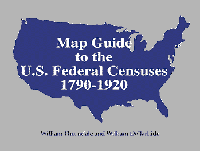
Upon completion of this lesson you will obtain copies of historical maps for the states in which an ancestor lived between 1850 to 1930. Then you will highlight or point out the area in which this ancestor lived, and notice the boundary changes.
The best book for doing this assignment if you are only focusing on the years the census records were taken in the United States is William Thorndale and William Dollarhide's, Map Guide to the U. S. Census. This book is available in the Family History Library, at most public libraries, at the MPC library if you happen to live around Monterey, California, as well as at most Family History Centers. The best computer program for doing this assignment is ANIMap which stands for Animated Map. It is available at the Family History Library and many local Family History Centers. These resources cover the United States census records only. You can also find historical census maps online by using www.cyndislist.com, or searching with Google.com.
TIPS FOR USING ONLINE CENSUS RECORDS
FIRST CONSIDER THE DATABASE
Database indexes are primarily finding aids to original records such as death, census, military, immigration, periodical, or land records. Today�s presentation will focus on foundation indices in database format and original scanned images linked to those databases which we can use in our research.
PITFALLS TO AVOID
Using electronic media may be fast, convenient, and available, but it has it�s own problems:
1. We might spend too much time learning to use the medium for it�s value.
2. Accepting as fact everything that you find. (These are secondary sources�check the original. I have found numerous omissions, several typing errors, and spelling problems.)
3. Publishers not properly documenting the sources published on an electronic resource which requires the researcher to be wise in using the source. Still try to locate the individual only using the given name, a different spelling for the surname, or in a different town in the county. Don�t assume if a person is not on a census index online as you expected that he is not found in that state for your individual.
4. The original spelling by the enumerator on the census records was usually phonetic, so learn to use all spelling variations possible. (Cannon was found spelled Canon, Caanan, Kaanan, and other ways.)
5. There is also the problem that information in digital format can be edited and changed so easily without leaving a trace. A thorough understanding of evidence is necessary as well as a knowledge of sources. The secret to successful research is understanding where our information comes from originally. (In one case the woman�s occupation was given as a Clergyman and the husband was without an occupation. I wanted to look at the original, but it was no longer available.)
6. The ease with which the source can be searched, entices the user to forget to make research logs or calendars. (Boy, this is a fact! Make a research planner of your goals and where you plan to go just as you would with published sources. Then mark them off as you accomplish them.)
A CASE STUDY
Online census searching can be very helpful for searching eastern Europeans with unusual names. I have been searching my step-father�s Yugoslavian families who landed at Ellis Island. The ship records indicated Chicago as their destination. That was a surprise. Everyone thought they had gone directly to Wyoming.
With the nationwide 1900 census at www.ancestry.com, and their unusual surname, I was able to locate them in Colorado a few years after their Chicago stay. Some of the men were working on the railroad and were found throughout states in the West including Texas, Wyoming, and Utah. One was even found in Pennsylvania working in the mines. I would never have looked in three of those states without the experience of testing the limits of the census search engines.
Searching for a more common name such as William Thompson was more difficult in 1900. The surname could have been Thomson, the given name could have been �W� or Bill. It takes hours to wade through common surnames in the entire United States looking only for a name. When this is your assigned task, start with the smallest locality where you think they will be such as a town, county, and state. Include a year of birth but give it +/- of 5 years just in case the date was difficult to read. If you must, just search given names in a specific locality and you may find that the first letter of the surname had been mistranscribed in the index.
|